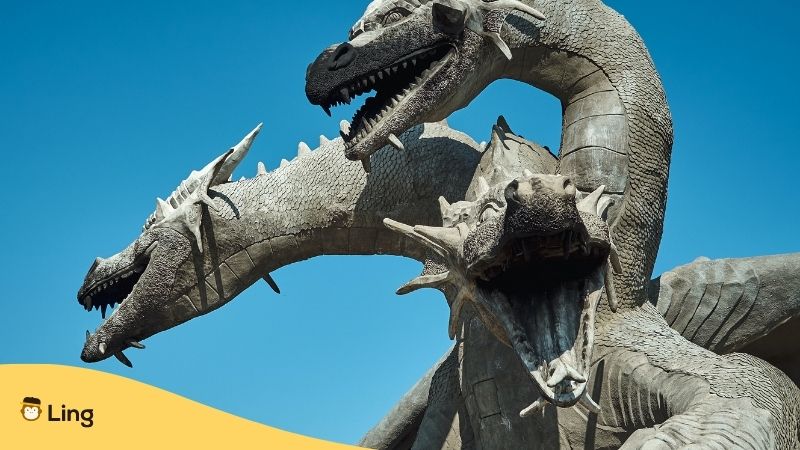Bonjour! Are you ready to delve into the enchanting world of French mythology? From the powerful gods and goddesses to the mischievous fairies, French mythology is filled with colorful characters and captivating stories. So grab your beret, a jambon and fromage baguette, and a string of garlic (just to be on the safe side in case of vampires), and let’s take a journey through this mystical, magical world.
After spending years trying to learn French, there’s one thing that made me progress quite a lot: Reading mythologies! By reading about these ancient stories and legends, you can improve your French language skills and gain a deeper understanding of French culture and history. Whether you’re exploring the tales of the legendary Tarasque or the Nain Rouge, French mythologies provide a rich and exciting source of inspiration that can spark your imagination and enrich your language-learning journey.
History Of French Mythology
The sheer number and variety of stories in French mythology hark back to when the country was divided into no fewer than 31 provinces, each with its own unique beliefs and customs. Historical and geographical differences have meant many of these distinct stories have survived into the present day. But if there’s one point in history that influenced French mythology a lot, then that would be the time of the Romans.
The Romans sacked France, then known as Gaul, in the second century AD, and this created a Gallo-Roman culture. In crept the mythology of the northern Gallic tribes, which included mythical creating a hairy or shaggy beast better known as the werewolf, and weird hybrid dead or supernatural beings made up of body parts collected from different animals and even humans! Later, Germanic migrants known as the Franks made their way into western Roman Gaul as the Roman Empire began to deteriorate, bringing their own beliefs, rituals, and superstitions.
Gallo-Roman Myths & Legends
Fi up, we have the mighty Zeus… wait, no, that’s Greek mythology! In Gaul, under the Romans, it was the powerful god Jupiter. Known as the god of the sky and thunder, Jupiter was the most important deity in the Roman pantheon. He was often depicted with a thunderbolt in his hand and an eagle at his side. But don’t let his intimidating appearance fool you. He was also a protector of the state and its citizens.
Next, we have the lovely Venus. Known as the goddess of love, beauty, and fertility, Venus was a popular deity in Roman mythology. She inspired the famous painting “The Birth of Venus” by Sandro Botticelli. She was often depicted as a beautiful woman surrounded by doves and roses.
Other Roman gods adopted by the Gauls included Mercurys, the creator of the arts; Apollo, who protected from disease, Minerva, the goddess of wisdom; and the mighty Mars, who was worshipped by the Gallic tribes in times of war.
The Druids
Anyone who has read The Adventures of Asterix will know that the Romans didn’t manage to do away with the influence of the druids and the influence of Celtic mythology after they invaded. In traditional Celtic paganism, sacrifices were made by the druids to Celtic gods and goddesses, not the Roman deities. Ironically, the druids did not keep written records of their ancient practice. Still, Julius Caesar and Pliny, the Elder did, and that’s how we know about their wicker statues, human and animal sacrifices, and other druidic rituals.
Prehistoric Standing Stones of Brittany
Probably put up during the Bronze and Iron Ages, the megaliths of northern France include dolmens and menhirs (see the Adventures of Asterix for more on these), probably used as temples and alters by the ancient Celts, or as tombs for priests, chiefs, and mighty warriors. The most famous of these are the Carnac stones.

Paganism And French Mythology In The Middle Ages
Fairies
In French mythology, fairies are known as fées. They are mischievous supernatural beings, or female spirits, that can be helpful and harmful to humans. They are said to have magical powers, such as granting wishes or casting spells.
Matagots
The matagot is a supernatural being similar to a fairy but from the south of France. Although they tend to be evil in intent, a matagot can be tempted to do nice things if you care for it, such as keeping it well-fed with a fresh and plump chicken. Usually, in the form of a black cat, you must not keep your matagot for too long as it will revert to its evil ways.

Dragons
Moving on, we have the mythical creatures known as dragons. In ancient stories and French mythology, they are fierce, fire-breathing beasts that often guard treasure or terrorize villages. The most famous French dragon appears in the story of Saint George and the Dragon (yep, the patron St of England was French). In one story, Saint George saves a princess from a dragon by slaying the beast with his sword.
Werewolves
Famous in the spooky stories and medieval folklore history in northern France, werewolves are said to have been men condemned to change shape because of their sins. Western cultures portray werewolves as beasts that transform into raving wild beasts when a full moon rises. The myth of the werewolf in France may hats roots in fear of cannibalism in ancient Brittany, but stories continued well into the 16th century.
Gargoyles
These stone creatures are often found on the roofs of Gothic buildings, such as the Notre Dame Cathedral and the Louvre Museum in Paris. In French mythology, gargoyles are said to ward off evil spirits and protect the building they are attached to, and they are often depicted as fearsome creatures with sharp teeth and claws.
French Mythology Words For Learning
Ready to read your first few mythologies? Before you do so, here are some French words to help you!
Learn French With Ling
So there you have it, a brief overview of French mythology. From rightful gods and goddesses to mischievous fairies and fearsome dragons, French mythology is a fascinating world filled with enchanting characters and captivating stories. If you would like to learn more about the French language and culture, then learning through the Ling app is the best way to go!
Thanks to its in-depth lessons and advanced features, you can learn to read and speak French engagingly. More importantly, it can help you understand whatever French-based media you want to use so long as you consistently try out the app for at least 15 minutes a day. Ready to give it a try? Download the Ling app from the Google Play Store or App Store today!




































































